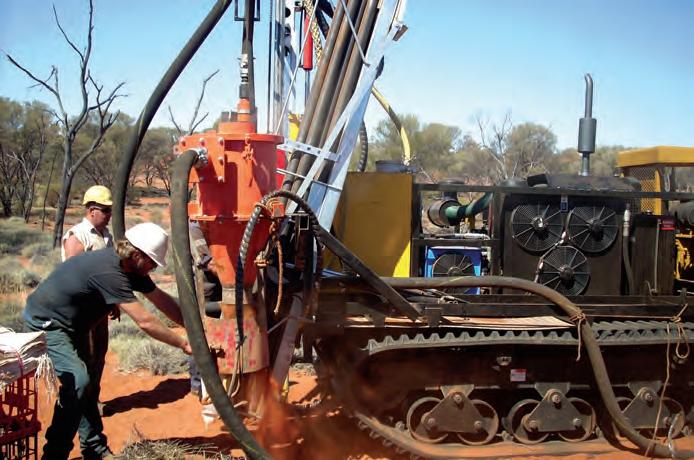
5 minute read
Sands shining brighter
Mineral sands are a hot topic in the Australian mining industry, with several mining companies advancing projects amid a growing demand for the commodities, writes Anthony Fensom.
Cyclone holds an estimated 6 per cent of global zircon supply.
Constrained supply and the world’s post-pandemic recovery have boosted the outlook for Australia’s mineral sands miners. With “critical minerals” such as zircon in demand, the industry is ramping up expansion plans, despite some regulatory roadblocks.
On November 24, the Victorian Government shocked the industry with its announcement blocking Kalbar Operations’ proposed Fingerboards mineral sands mine in East Gippsland.
Amid organised community opposition, Victorian Planning Minister Richard Wynne ruled against the project, describing it as posing a “significant risk to the environment and valuable horticulture industry”.
However, on January 11, ABC News reported that the federal agriculture department was reviewing the rejected application under Commonwealth law, with Kalbar stating it was “already addressing the recommendations for the next phase of approvals”.
The potential blocking of the project has highlighted the obstacles to further supply growth, not only in Australia but also internationally.
In a November 10 presentation, major producer Iluka Resources noted the challenges facing the industry, including the COVID-19 pandemic, logistics, climate change, escalating sovereign risks, declining grades at existing mines and the delay of new projects.
The company’s presentation to a TZMI conference also noted the “decreasing supply of low uranium and thorium zircon”, with China’s strict enforcement of radiation limits also impacting supply.
While more than 95 per cent of current zircon supply contains less than 500 parts per million (ppm) uranium and thorium, less than half of potential new projects meet this criteria.
“Absent a processing solution to remove these impurities, the zircon is ineligible for sale into the ceramics market,” Iluka’s Matthew Blackwell, speaking at the TZMI conference, says.
However, Iluka reported increased zircon prices in the third quarter of 2021, with a weighted average received price of $US1487 ($2079) per tonne. This compared to the $US1311 per tonne received during the prior year’s corresponding quarter.
“Overall, the ceramics industry is experiencing sustained growth in sales. However, profitability is being challenged by increasing costs throughout

Diatreme chief executive officer Neil McIntyre.
the supply chain,” Blackwell says.
However, he noted “ongoing supply-side tightness” with the company’s fourth-quarter sales volumes “fully committed”.
Titanium is also seeing a recovery, with the third-quarter rutile price reaching $US1242 per tonne, in line with its last high seen in 2020, following the temporary shutdown of Rio Tinto’s Richards Bay mine in South Africa and the continued suspension of Iluka’s Sierra Leone mine.
Blackwell pointed to “unprecedented” logistics costs associated with container shortages in China, with North American and European pigment producers also facing chlorine shortages.
Similar to zircon, Iluka sees a constrained supply outlook for rutile, with declining high-grade feedstock from existing producers and limited new supply due to high capital costs, increasing jurisdictional risks and low rutile assemblage of new projects.
The company also pointed to its project pipeline, including its Atacama deposit in South Australia’s Eucla Basin, the Balranald project in the Murray Basin, and phase 2 of the Eneabba project in Western Australia, with a decision on the resumption of its Sierra Leone rutile mine still “pending”.
NEW PROJECTS
Boasting the world’s largest mineral sands deposits, Australia’s mineral sands industry sees potential for growth, particularly amid global supply constraints.
Among the next wave of projects is Diatreme Resources’ Cyclone zircon project, located in the zircon-rich Eucla Basin of Western Australia.
“Cyclone has the potential to become a significant supplier, accounting for an estimated 6 per cent of global zircon supply,” Diatreme chief executive officer Neil McIntyre says.
“Shovel-ready with all necessary approvals and permitting, the Cyclone project is set for development amid an environment of shrinking supply of highgrade zircon.”
A 2018 definitive feasibility study showed a post-tax net present value of $113 million, an internal rate of return of 27 per cent and capital payback within three years.
With the strategic rare metal, hafnium, also identified within the zircon component of Cyclone’s heavy mineral concentrate, the project could be even more valuable.
“We’re seeking a development partner to take Cyclone forward into production, at a time when projects of this quality are hard to find,” McIntyre says.
“With no shortage of demand for highgrade zircon and constrained supply, Cyclone is in an excellent position to advance into development.”
Other WA mineral sands miners are also moving to increase production, including through merger and acquisition activity.
In November 2021, Image Resources announced the $24 million acquisition of mineral sands tenements in WA’s historic Eneabba mining district from Sheffield Resources.
Image said the tenements contained 211 million tonnes of 3 per cent heavy minerals, with the company seeking to “identify and secure potential development projects outside of its current portfolio”.
The Perth-based company has a portfolio of 12 zircon and titanium projects in WA, led by its operating Boonanarring mine, with its second and third projects expected to be developed following the depletion of Boonanarring’s ore reserves.
Sheffield Resources has continued to advance its Thunderbird mineral sands project, with the company aiming to complete a definitive feasibility study and secure project financing ahead of a final investment decision, expected in early 2022.
Another aspiring producer, Strandline Resources, announced on January 17 that construction was 50 per cent complete at its Coburn mineral sands project in WA.
The company is targeting first production of heavy mineral concentrate during the December quarter 2022, with current market spot prices for zircon and titanium feedstocks “at least 25 per cent” above its original assumptions.
In south-west WA, Astro Resources aims to launch a pre-feasibility study at its Governor Broome heavy mineral sands project, with the company also acquiring some tenements from Iluka Resources.
Meanwhile on the east coast, Astron Corporation has flagged the potential start of construction in 2024 at its Donald mineral sands project in Victoria.
With analysts pointing to a widening global supply deficit, Australia’s mineral sands miners appear set to capitalise.
“Australia is in the right place at the right time, with the opportunity to supply growing global markets with high-grade mineral sand resources in an environmentally sustainable manner,” Diatreme’s McIntyre says.
“Demand for our products continues to rise and Australian miners are well placed to benefit.”

Drilling at Diatreme’s Cyclone zircon project in WA.










